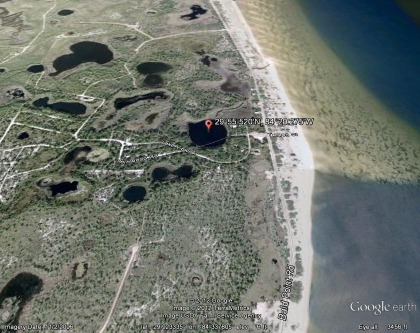- Apr 1, 2011
- 169,942
- 47,187
- 2,180
Frequency of strong Florida hurricanes decreased in last 600 years | Watts Up With That?
The next time some alarmist caterwauls about hurricanes becoming worse and more frequent due to global warming, show them this study.

Mullet Pond: a nearly circular, 200-m-diameter cover-collapse sinkhole located on Bald Point near Apalachee Bay, Florida from which the paleo data on hurricane frequency was obtained. Image: Google Earth
Noting that the brief observational record is inadequate for characterizing natural variability in hurricane activity occurring on longer than multi-decadal timescales, Lane et al. (2011) sought a means of characterizing hurricane activity prior to the period of modern measurement and historical record keeping, due to the fact that the manner in which tropical cyclone activity and climate interact has critical implications for society and is not well understood.
Specifically, Lane et al. developed a 4500-year record of intense hurricane-induced storm surges based on data obtained from a nearly circular, 200-m-diameter cover-collapse sinkhole (Mullet Pond: 29°55.520′N, 84°20.275′W) that is located on Bald Point near Apalachee Bay, Florida, USA, where (1) recent deposition of sand layers in the upper sediments of the pond was found to be contemporaneous with significant, historic storm surges at the site modeled using SLOSH and the Best Track, post-1851 AD dataset, where (2) paleohurricane deposits were identified by sand content and dated using radiocarbon-based age models, and where (3) marine-indicative foraminifera, some originating at least 5 km offshore, were present in several modern and ancient storm deposits.
The four researchers reconstructed record of intense hurricanes revealed that the frequency of these high-magnitude events peaked near 6 storms per century between 2800 and 2300 years ago. Thereafter, it suggests that they were relatively rare with about 0-3 storms per century occurring between 1900 and 1600 years ago, after which they state that these super-storms exhibited a marked decline, which began around 600 years ago and has persisted through the present with below average frequency over the last 150 years when compared to the preceding five millennia.
It is instructive to note that over the past century and a half of ever-increasing fossil fuel utilization and atmospheric CO2 buildup, the frequency of the most intense category of hurricanes in the Northeastern Gulf of Mexico has been lower than it was over the prior five millennia, which speaks volumes about the climate-alarmist claim that continued anthropogenic CO2 emissions will lead to more frequent super cyclones and hurricanes.
The next time some alarmist caterwauls about hurricanes becoming worse and more frequent due to global warming, show them this study.

Mullet Pond: a nearly circular, 200-m-diameter cover-collapse sinkhole located on Bald Point near Apalachee Bay, Florida from which the paleo data on hurricane frequency was obtained. Image: Google Earth
Noting that the brief observational record is inadequate for characterizing natural variability in hurricane activity occurring on longer than multi-decadal timescales, Lane et al. (2011) sought a means of characterizing hurricane activity prior to the period of modern measurement and historical record keeping, due to the fact that the manner in which tropical cyclone activity and climate interact has critical implications for society and is not well understood.
Specifically, Lane et al. developed a 4500-year record of intense hurricane-induced storm surges based on data obtained from a nearly circular, 200-m-diameter cover-collapse sinkhole (Mullet Pond: 29°55.520′N, 84°20.275′W) that is located on Bald Point near Apalachee Bay, Florida, USA, where (1) recent deposition of sand layers in the upper sediments of the pond was found to be contemporaneous with significant, historic storm surges at the site modeled using SLOSH and the Best Track, post-1851 AD dataset, where (2) paleohurricane deposits were identified by sand content and dated using radiocarbon-based age models, and where (3) marine-indicative foraminifera, some originating at least 5 km offshore, were present in several modern and ancient storm deposits.
The four researchers reconstructed record of intense hurricanes revealed that the frequency of these high-magnitude events peaked near 6 storms per century between 2800 and 2300 years ago. Thereafter, it suggests that they were relatively rare with about 0-3 storms per century occurring between 1900 and 1600 years ago, after which they state that these super-storms exhibited a marked decline, which began around 600 years ago and has persisted through the present with below average frequency over the last 150 years when compared to the preceding five millennia.
It is instructive to note that over the past century and a half of ever-increasing fossil fuel utilization and atmospheric CO2 buildup, the frequency of the most intense category of hurricanes in the Northeastern Gulf of Mexico has been lower than it was over the prior five millennia, which speaks volumes about the climate-alarmist claim that continued anthropogenic CO2 emissions will lead to more frequent super cyclones and hurricanes.

